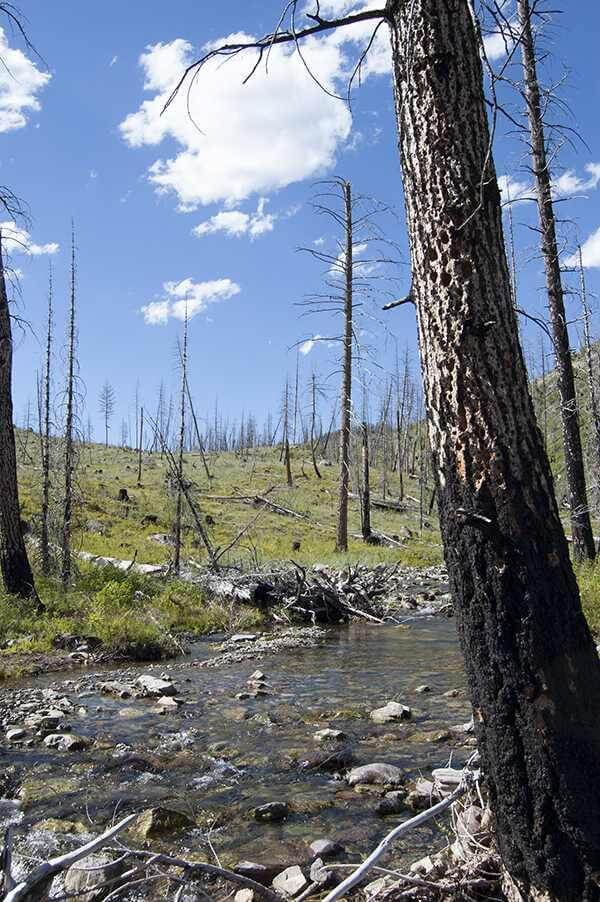Why Dead Standing Trees are Essential to Forests
by Emily Miller
Broadcast 2.2.2015.

Photo by Josh Burnham (CC-BY-NC-2).
Listen:
One of my favorite places to look in the forest is up. I love the way trees frame patches of sky, and how rays of sun slide over the branches and slant into pockets of darkness. On a recent stroll through the woods near Echo Lake, I found myself, as usual, looking up. I saw mostly fir and birch trees, and I took their narrow trunks and modest heights as signs of a young forest. But it was a much older tree that caught my eye.
A hulking snag towered some 15 feet above the forest’s thin canopy, charred a uniform black from the ground all the way up to its sharp tip. There were few other signs of fire, and I figured this snag had probably burned years before the trees around it were even saplings.
So the burnt snag was a survivor, one of the last remnants of a different forest that was now long gone. But I wondered, do snags actually serve a purpose? What creatures could possibly make use of this dark, uninviting carcass?
Standing dead snags are indeed essential to the forest community. They are often centers of activity, providing several services to many forms of life. In some areas, up to 60 separate types of organisms have been observed to inhabit a single snag.
Technically speaking, a snag is an upright section of a dead tree stem. They are at least six inches in diameter and over 20 feet high, but snags come in all sorts of shapes and sizes. Each snag is classified as hard or soft, which determines the plants and animals that will most likely be found inside. A hard snag is younger, burnt more recently, and may still have some bark and branches. A snag softens as it ages. In its most advanced stage it falls over and becomes a log, performing a different set of forest functions.
While it remains standing, which can be decades, a single snag crawls with moss, lichens, fungi and invertebrates, as well as several birds, bats and mammals like flying squirrels and martens.
The highest profile snag-users though may be cavity-nesters. As the name suggests, these are birds that take advantage of a snag’s softening wood, and carve out little caves for themselves, or sometimes use already-existing hollows in a tree.
Woodpeckers are an especially noisy type of cavity-nester, and are highly-adapted to using snags. They test each dead tree for hardness, boring into its wood and listening for a special resonance that indicates a soft core, and thus a potential home. The softer the tree, the easier the nesting, and tattooed snags, pecked and rejected throughout the forest, suggest woodpeckers can be fairly choosy in their snag-selection process.
But snags offer more than just a home for the cavity-nester. Both Black-Backed and Three-Toed Woodpeckers seek out burnt snags for both shelter and food. Many cavity nesters eat mostly beetles and larvae, which are found under burned bark. Think of the snag as a one-stop shop for forest creatures.
What’s more, the beetles depend on snags, too. Many types thrive on nutrients under snag bark, and even have special skills to find burnt trees. Melanophila beetles, for example, have infrared sensors that can detect charred groups of trees from up to 100 miles away.
And that’s not all. Other birds, such as flycatchers, swallows, and owls use snags as hunting launch pads. They scope out their prey from above, enjoying the snag’s high, often hidden, perch. And mammals, including flying squirrels and American martens, use snags as hideouts and rest spots.
So the next time you’re in the forest, pause for a moment at the foot of an old snag. Maybe you’ll hear the tap-tap-tap of a woodpecker’s beak, echoing through a quiet forest, or be lucky enough to glimpse an owl tucked into a rotting tree trunk. Perhaps you’ll let your eyes wander up its trunk, and you’ll appreciate, as I did, how the great snag grabs your gaze, pulls it up, and throws it straight at the sky.
Every week since 1991, Field Notes has inquired about Montana’s natural history. Field Notes are written by naturalists, students, and listeners about the puzzle-tree bark, eagle talons, woolly aphids, and giant puffballs of Western, Central and Southwestern Montana and aired weekly on Montana Public Radio.
Click here to read and listen to more Field Notes. Field Notes is available as a podcast! Subscribe on iTunes, Google Play, or wherever you listen to podcasts.
Interested in writing a Field Note? Contact Allison De Jong, Field Notes editor, at adejong [at] montananaturalist [dot] org or 406.327.0405.
Want to learn more about our programs as well as fun natural history facts and seasonal phenology? Sign up for our e-newsletter! You can also become a member and get discounts on our programs as well as free reciprocal admission to 300+ science centers in North America!












